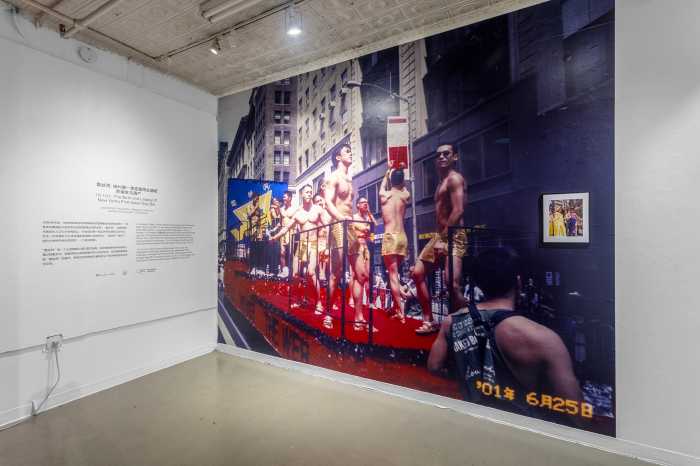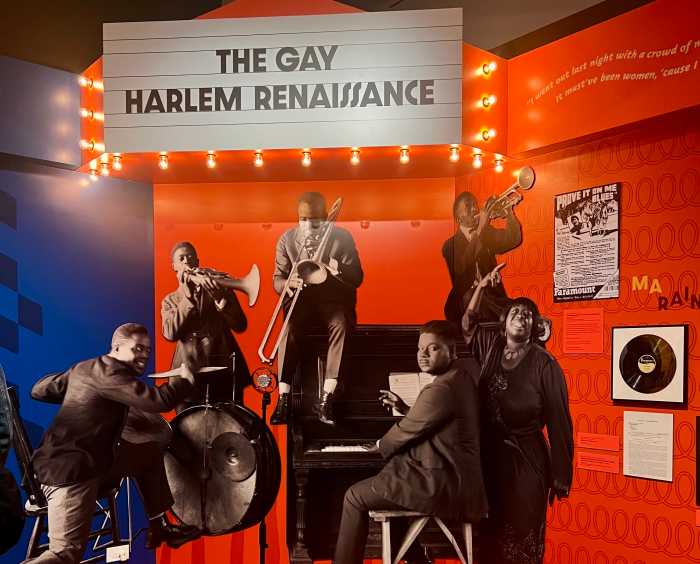BY ANDREW CORNELL ROBINSON | Artist Alex Da Corte's current body of photographs and sculptural installation examines evidence of power dynamics in human relationships. His work deals with appearances and intimacy – the potency of what lies beneath appearances. His interest is in the soul rather than the surface of the work, the person, or the subject.
In order to create a series of what Da Corte calls “activities,” he cruises straight men in public parks, and engages them in collaborative art experiments. Each participant is asked to repeatedly perform an activity over a one-to-three day period, until Da Corte feels he has caught his subject in a moment of “letting go” – the social mask of masculine bravado giving way to a more vulnerable self-expression.
ALEX DA CORTE
“I Attach Myself to You”
Stonefox Artspace
611 Broadway at Houston St.,
Suite 405
Mon.-Fri. noon-6 p.m.
Through Feb. 12
212-473-7900
The activity project evolved from Da Corte himself acting as the model, performing different self-appointed tasks as a cure for loneliness. A 27-year-old gay man, he describes these situations: “If I'm asking people to do things they normally wouldn't do, I feel some obligation to get out of my comfort zone. These people have very real lives. All these people that I see in the park, they know that I'm gay. I seek out men who I assume are straight hoping to engage them in a relationship that brings about feelings of fear, anxiety, rejection, embarrassment, excitement, lust, etc.”
Da Corte's activities explore those awkward personal interactions and while they result in compelling photographs and curious, near-comic installations – such as paper party streamers that spell out phrases like “I love you so much it makes me sick” and flags comprised of weathered burlesque fringed garments – there is an insidious undercurrent in the work that captures an unspoken tension evidenced by what takes place.
As Da Corte explains, “It's totally awkward. It's not fantasy; it's not about the prelude to a wild and sexy time. It's the exact opposite.”
The artist creates these activities as a safe and non-threatening platform from which a man can act as freely as he pleases, armed however with the knowledge that the output could show up as a MySpace photo or Google image which all the world may one day see. But in the moment that defines the activity, the participant is the star and creator of whatever personae he chooses to present.
By removing the potential for sex, the gay artist and the willing straight participant in the activity meet as equals; the transaction becomes an exploration of what a real human interaction is about. These activities celebrate something as basic as a conversation as a comedy of social intercourse. The evidence that emerges from these activities can be rich color photographs depicting a young man captured in transgressive moments, as he rolls around half-naked in glitter or lays prone on his back while the artist shoves berries into his face and mouth. The work is all at once comedic, charming, aggressive, and seductive.
Da Corte's work departs in a significant way from the canon of queer gaze. Consider how other artists such as Paul Cadmus, Robert Mapplethorpe, Jack Pierson, and Nayland Blake, among many, utilize the queer gaze, using the male figure as an object of beauty, lust, and taboo desire. Their approach is contextualized, to some degree, by the oppressive weight of social, religious, political, and public policies – to which the artists are responding – that directly admonish and attempt to erase the queer eye from the world. A common conceptual theme that ties together the responses to that threat is transgression against civil society's boundaries in celebration of what is perceived by the straight world as abject and forbidden.
Da Corte continues in this tradition, but I think he brings something new to the visual vocabulary of the queer gaze – recognition that the power dynamics of the queer eye and the object of desire can in fact be equal participants, both of them accessible and vulnerable.
According to the artist, “These experiences break down ideas of fantasy, stereotypes, power roles – and develop the idea of the other as someone not very different from the self.”
The artist attempts to return some humanity to the interaction between his gaze-and by extension ours-and the objectified corpus of the model. Da Corte's is a radical reaction to the context of contemporary conversations too often mediated by a digital cacophony of acronyms devoid of emotion that supplant real human interaction.


































